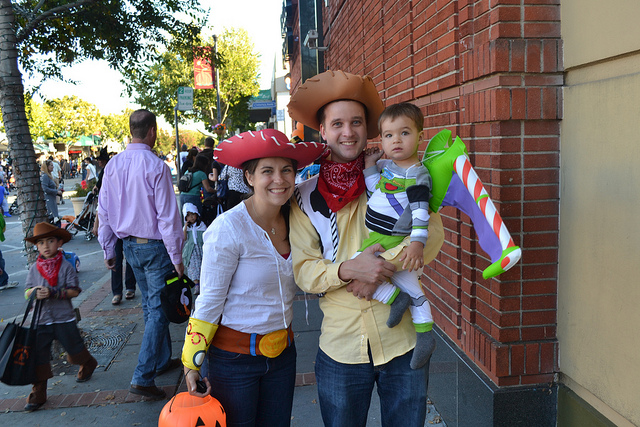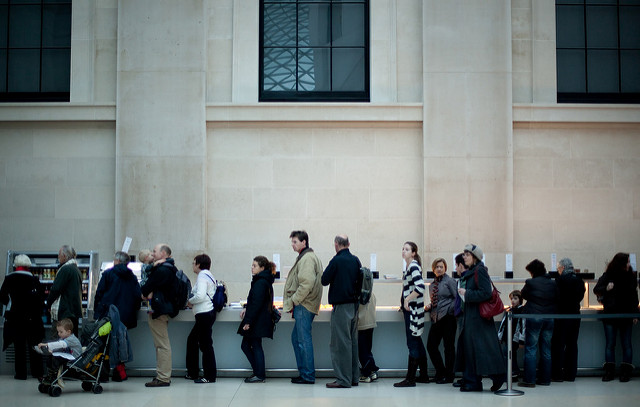Unlock the Magic in Your Story Now
Get the Free 20 questions to Ask Before Launching Your Idea workbook when you sign up for occasional updates.
Get the Free 20 questions to Ask Before Launching Your Idea workbook when you sign up for occasional updates.
Articles filed in: Marketing
The Three-Act Structure For Brand Stories
filed in Marketing, Storytelling
 Every movie you’ve ever watched follows a three-act structure. The screenwriter sets the scene, introducing us to the hero and the main characters. We get a glimpse of his world, relationships and challenges. In the second act, we see the hero attempt to solve his problems or overcome obstacles.
Every movie you’ve ever watched follows a three-act structure. The screenwriter sets the scene, introducing us to the hero and the main characters. We get a glimpse of his world, relationships and challenges. In the second act, we see the hero attempt to solve his problems or overcome obstacles.
In Toy Story, we’re introduced to Woody who has been Andy’s favourite toy forever. Buzz Lightyear comes along and turns Woody’s world upside down. The whole plot is about how Woody deals with the resulting conflicts while remaining loyal to Andy and true to his values.
We can use this three-act structure in our brand stories, remembering that the customer, not the brand is the hero.
The Three-Act Structure For Brand Stories
SETUP: The customer’s backstory unfolds
We explore his hopes, dreams, wants, needs, values, worldviews, and challenges.
CONFRONTATION: The struggle arises
The customer attempts to solve his problem or fulfil his need and often realises he needs help.
RESOLUTION: Challenges are overcome
The customer’s need is met. He manages to do the thing he wanted to do, but couldn’t.
He is changed, has a new sense of self and set of beliefs about what’s possible.
Analyse any great product or service story from the IKEA chair to Blue Apron meal kits, from Warby Parker to charity: water and you’ll see it follows this three-act structure.
How does your story stack up?
Do you want to tell a better brand story? The Story Strategy Course will show you how.
Image by David Werner.
Why Do They Come?
filed in Marketing, Storytelling
 There was a twenty-minute wait for croissants at Lune long before the New York Times announced that the best croissants in the world might just be made in Melbourne. Now you can wait for thirty, but people still get up early and hang in there just to try one.
There was a twenty-minute wait for croissants at Lune long before the New York Times announced that the best croissants in the world might just be made in Melbourne. Now you can wait for thirty, but people still get up early and hang in there just to try one.
Why would they take a tram across town for a $5 pastry?
Why does someone buy a Maserati, not a Tesla?
Why don’t cinema goers save the $20 and stay at home with Netflix?
Why do your customers come to you?
It’s not possible to tell your story effectively without knowing the answer to this question.
How many of the reasons that you list are reflected in your marketing?
Inage by Lars Ploughmann.
Common Ground
 One blustery Saturday morning last month our entire neighbourhood woke to a marketing blitz. Every single home in every street had been targeted. The instructions to the leaflet dropper had been clear. Don’t post the flyer in the letterbox (where people won’t be looking for mail at the weekend). Place each one on the doorstep or somewhere obvious right outside the door, so when the occupant wakes up hungry at the weekend our breakfast pizzas are top of mind.
One blustery Saturday morning last month our entire neighbourhood woke to a marketing blitz. Every single home in every street had been targeted. The instructions to the leaflet dropper had been clear. Don’t post the flyer in the letterbox (where people won’t be looking for mail at the weekend). Place each one on the doorstep or somewhere obvious right outside the door, so when the occupant wakes up hungry at the weekend our breakfast pizzas are top of mind.
The result was a flurry of pink (because pink will stand out) marketing spam, literally flying around the neighbourhood. Hours of resources—time, money, energy and trees wasted in an attempt to reach everyone.
We’d never dream of engaging someone in conversation without trying to understand their worldview. That’s why small talk exists, not to fill awkward silences, but so we can find common ground. And so it goes for marketing. It’s a two-way exchange, an alignment of value and values, of needs, understood and met—or at least at its best it should be.
Image by Kerry Lannert.
10 Questions To Ask Before You Do Any Marketing
 It’s fun to think about getting our products and services in the hands of the people we want to serve. In our rush to increase brand awareness we often overestimate the importance and impact of short-term, tactical marketing decisions. It’s possible to put things in perspective by answering some questions about your objectives before you begin.
It’s fun to think about getting our products and services in the hands of the people we want to serve. In our rush to increase brand awareness we often overestimate the importance and impact of short-term, tactical marketing decisions. It’s possible to put things in perspective by answering some questions about your objectives before you begin.
10 Questions To Ask Before You Do Any Marketing
1. Is the product good enough?
2. Why is this the best way to grow our business?
3. Does this type of marketing align with our brand values?
4. Is this the best way to delight customers?
5. Could we do more if we spent the money differently?
6. Are we proud to put our name to this?
7. Why are we doing it this way?
8. What’s the alternative?
9. How will we know if it worked?
10. What exactly is the return we want from this marketing initiative (campaign, sponsored post, leaflet drop, product giveaway, collaboration and on and on)?
If it’s the right thing to do you’ll know.
Image by Philip Bouchard
The Real Role Of Storytelling In Marketing
filed in Marketing, Storytelling
 When we think about using storytelling as a marketing tactic we often get confused about the purpose of the story. Most marketing tries to tell the story of the product. We invite prospective customers to pay attention to our widget by describing what it does or why it’s better and think we’re telling a story.
When we think about using storytelling as a marketing tactic we often get confused about the purpose of the story. Most marketing tries to tell the story of the product. We invite prospective customers to pay attention to our widget by describing what it does or why it’s better and think we’re telling a story.
Analyse any piece of marketing collateral that resonates with you and you’ll realise that the company doesn’t tell the story of the product at all. What they do instead is tell the story of the customer in the presence of the product. The customer, not the product is the hero of the story.
From Apple’s ‘Shot on iPhone’ billboards and IKEA’s ‘Start Something New’ folding chair, to Cook Republic’s Panna Cotta and Johanna Basford’s colouring books. The customer is the star of the show and the product is the supporting act.
Your job is to show your customer how your product makes him the hero of his story.
Image by Billie Grace Ward.
The Thing That’s Worth Measuring
 Josh is a sales assistant at a sports store in the city. He proactively solves customer’s problems while they browse, taking the time to answer questions about the equipment they’re considering buying. If one of those interactions results in a sale Josh adds a new barcode containing his employee ID to the product. This is how Josh’s performance is tracked.
Josh is a sales assistant at a sports store in the city. He proactively solves customer’s problems while they browse, taking the time to answer questions about the equipment they’re considering buying. If one of those interactions results in a sale Josh adds a new barcode containing his employee ID to the product. This is how Josh’s performance is tracked.
Every sales assistant then is only as good as the number of sales he can prove he’s facilitated. This is the performance metric the store manager pays attention to because it’s the thing she can easily measure. Josh can spend twenty minutes with a shopper exchanging valuable information about golf clubs. This might result in a sale next week or an online purchase at a later date. Josh’s efforts will likely go unnoticed and unacknowledged by management.
An uptick in a metric of any kind can feel like progress which of course is fun to measure, but much of what adds value to our businesses (lives, families, and cultures too) is intangible. When we limit ourselves to believing that hard data tells the whole story we’re missing opportunities to improve those things we can’t put a number on.
Just because data is easy to collect doesn’t mean it’s the thing that’s worth measuring. It’s important to question exactly how the data we gather is helping us to achieve our goals before obsessing over what the numbers look like.
Image by Antoine Robiez.
Why Are Your Customers Here?
 The city centre bookstore manager complains to her colleague on the phone about people wandering in on their lunch break to browse because they have nothing else to do.
The city centre bookstore manager complains to her colleague on the phone about people wandering in on their lunch break to browse because they have nothing else to do.
“They’re not coming in for anything in particular.” she sighs.
She’s right, for two hours every day hundreds of office workers with nothing else to do pass by her door. Contrast her story to that of Powell’s bookstore—a Portland institution. Powell’s is a destination, a treat for locals and visitors alike. The management at Powell’s understands that people don’t visit bookstores just because they’re short of something to read.
There isn’t a single beloved brand that relies on stacking the shelves and opening the door as its killer marketing strategy. That’s not how marketing works in the twenty-first-century.
Every store you visit, app you use or podcast you listen to, has given you a reason to come. The owners and creators know why you’re there and what you want deep down.
Why are your customers here?
Image by Florent Lamoureux.
True Advantages
filed in Marketing, Storytelling
 If I asked you to list the advantages any global brand has over its competitors you’d likely think of things like access to capital, distribution networks, and other resources that the average business doesn’t have. But these brands are the outliers.
If I asked you to list the advantages any global brand has over its competitors you’d likely think of things like access to capital, distribution networks, and other resources that the average business doesn’t have. But these brands are the outliers.
When it comes down to it, most businesses have access to similar resources, raw materials, and human capital. Every pizza is made with flour, cheese, and tomato. So why do queues form at this place and not that one? What drives the demand that’s responsible for success?
The one true advantage we all have at our fingertips is how we make people feel, and the story they leave with. Sometimes that story is a two-hour wait, a $5 price tag for a single slice, or a hand-made pizza crafted by a man who has been making them for 50 years.
Understanding how people will tell the story to others is an advantage every business can own.
Image by Lucas Richarz.
 It’s easy to think of great examples of B2C (business-to-consumer) brand storytelling. The list of B2C companies that leverage storytelling to engage with their customers’ grows daily. The perception in many B2B (business-to-business) companies is that it’s easier to engage with customers through story when you’re selling running shoes with a dose of ‘Just Do It’ motivation. Then there is the concern in B2B about justifying the resources and measuring the return on investment (ROI) in brand storytelling to stakeholders.
It’s easy to think of great examples of B2C (business-to-consumer) brand storytelling. The list of B2C companies that leverage storytelling to engage with their customers’ grows daily. The perception in many B2B (business-to-business) companies is that it’s easier to engage with customers through story when you’re selling running shoes with a dose of ‘Just Do It’ motivation. Then there is the concern in B2B about justifying the resources and measuring the return on investment (ROI) in brand storytelling to stakeholders.  The Content Marketing Institute recently
The Content Marketing Institute recently